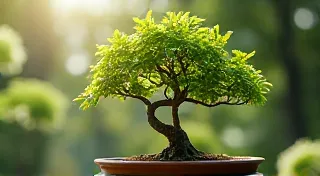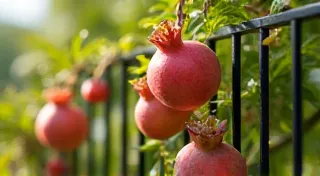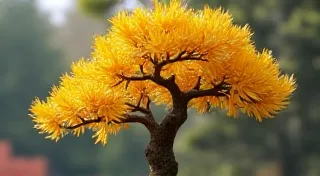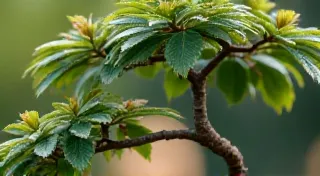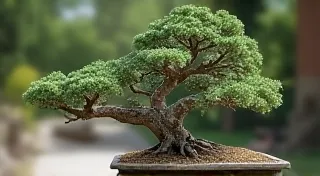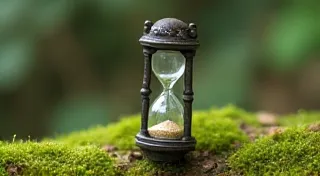Boxwood Bonsai: Classic Style and Evergreen Beauty
The Boxwood bonsai is a cornerstone of bonsai aesthetics. Revered for its dense, compact foliage and elegant branching, it represents a classic style that embodies the art of miniature tree cultivation. This guide provides a comprehensive overview of creating and caring for a Boxwood bonsai, from initial styling to ongoing maintenance. Whether you’re a seasoned bonsai enthusiast or a beginner eager to learn, this article will equip you with the knowledge to nurture a thriving and beautiful Boxwood bonsai.
Understanding Boxwood: The Ideal Bonsai Species
Boxwoods (genus Buxus) are naturally robust, compact shrubs, making them exceptionally well-suited for bonsai. Their ability to tolerate heavy pruning and readily bud from old wood is critical to shaping and maintaining the desired bonsai form. Several Boxwood species are commonly used in bonsai, including Buxus sinensis (Chinese Boxwood), Buxus koreana (Korean Boxwood), and Buxus microphylla ‘Japanese Boxwood’. While all are suitable, their growth habits and leaf size may differ slightly, influencing styling choices. Choosing the right species is crucial, and exploring options like the beautiful Korean Hornbeam bonsai can broaden your understanding of the possibilities within the world of miniature trees.

Styling a Boxwood Bonsai
Boxwoods lend themselves well to several classic bonsai styles, including Formal Upright, Informal Upright, Slanting, and Cascade. The initial styling often involves selecting a suitable trunk and branch structure. The goal is to create an illusion of an ancient, windswept tree. Considering the seasonal changes that influence tree form is essential, and understanding how trees like the graceful Larch bonsai adapt to their environment can provide inspiration for your Boxwood styling.
Branch Selection & Positioning
Careful branch selection is paramount. Choose branches that radiate outward and upward, creating a balanced and visually appealing silhouette. Eliminate branches that cross, grow downward, or are too thick compared to the trunk. Wiring is frequently used to reposition branches into the desired angles. Be sure to protect the bark with raffia when wiring, and check regularly to prevent it from cutting in.
Trunk Development
Creating a tapered trunk is crucial for the aged look. This can be achieved through careful pruning and the use of selective fertilization. Pruning the lower branches encourages back budding, which can thicken the trunk base. Periodically rotating the bonsai ensures even growth on all sides. Understanding the impact of seasonal changes is paramount – trees like the vibrant Crabapple bonsai showcase how color and form evolve throughout the year.
Boxwood Bonsai Care
Watering
Boxwoods prefer consistently moist, but not waterlogged, soil. Water when the topsoil feels slightly dry to the touch. The frequency of watering will depend on factors like climate, pot size, and soil type. Ensure the pot has adequate drainage to prevent root rot.
Light
Boxwoods thrive in full sun to partial shade. While they can tolerate full sun, afternoon shade is beneficial in hotter climates to prevent leaf scorch. Rotate the bonsai regularly to ensure even light exposure.
Soil
A well-draining bonsai soil mix is essential. A common mix consists of akadama, pumice, and lava rock. This combination provides excellent drainage and aeration, preventing root problems.
Fertilizing
Feed your Boxwood bonsai regularly during the growing season (spring and summer) with a balanced fertilizer. Reduce or eliminate fertilization during the dormant season (fall and winter).

Pruning
Pruning is a continuous process with Boxwood bonsai. Regular pinching and pruning of new growth maintains the desired shape and encourages ramification (branching). Structural pruning, involving the removal of larger branches, is typically done in late winter or early spring. The principles of pruning apply across a wide range of species; for example, understanding how to achieve a miniature majesty with a Dwarf Ponderosa Pine bonsai can inform your Boxwood pruning techniques.
Common Problems & Solutions
Beyond the core care, it's crucial to understand potential issues and how to address them. Maintaining a healthy bonsai requires a comprehensive approach, encompassing not only watering and fertilization but also preventative measures against pests and diseases. This is especially important for evergreen varieties like Boxwood, which can be susceptible to certain ailments. Here's a look at some of the most common problems encountered with Boxwood bonsai and the solutions to keep your tree thriving.
- Leaf Scorch: Reduce exposure to intense sunlight or increase watering.
- Root Rot: Improve drainage and avoid overwatering.
- Boxwood Blight: A fungal disease. Treat with a fungicide and improve air circulation.
- Spider Mites: Treat with insecticidal soap.
Delving Deeper: Advanced Boxwood Bonsai Techniques
Once you’re comfortable with the fundamentals of Boxwood bonsai care, you can explore more advanced techniques to refine the artistry and health of your tree. These techniques often involve a deeper understanding of plant physiology and meticulous attention to detail. Let's explore several advanced aspects of Boxwood bonsai cultivation.
Trunk Bending and Root Development
Creating a truly aged appearance goes beyond simply tapering the trunk. Advanced techniques involve carefully bending the trunk to simulate the effects of wind and time. This requires patience and a strong understanding of how to encourage growth in specific directions. Similarly, encouraging a robust root system is crucial for long-term health. This often involves carefully managing the pot size and soil composition.
Jin and Shari Application
Jin (deadwood branches) and shari (exposed trunk) are aesthetic elements that contribute to the aged appearance of a bonsai. Applying these elements involves removing the bark from branches or the trunk, often with the aid of specialized tools. This technique is not for the faint of heart, as it requires careful planning and execution to avoid harming the tree.
Seasonal Considerations for Advanced Care
While the basic care principles remain consistent throughout the year, advanced care often involves nuanced adjustments based on the specific seasonal conditions. For instance, during the intense heat of summer, careful attention must be paid to preventing leaf scorch, while in the winter, protection from frost may be necessary. Understanding the unique challenges of each season is key to maintaining a thriving Boxwood bonsai.
Conclusion
Creating and caring for a Boxwood bonsai is a rewarding experience. With patience, dedication, and an understanding of the species' needs, you can cultivate a timeless work of art that embodies the beauty and serenity of the natural world. The classic style and evergreen foliage of the Boxwood bonsai make it a cherished addition to any bonsai collection. From the basics of watering and pruning to the intricacies of trunk bending and jin application, the journey of a Boxwood bonsai is a testament to the power of dedication and artistic vision.

